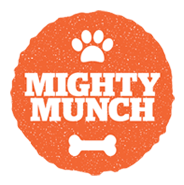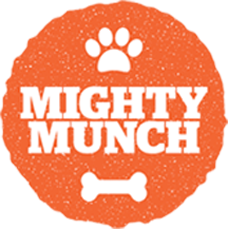Maintaining your dog's dental hygiene is an essential part of keeping them healthy and happy. Dogs are prone to plaque buildup, gum disease, and other dental issues if their teeth aren't properly cared for. These issues can cause your dog significant pain and discomfort, and up to thousands of dollars in vet bills.
Prevention is the key to keeping your dog’s oral care in check, and brushing your dog’s teeth is a big part of that. So, can I brush my dogs teeth with toothpaste? Yes - you can. In this guide, we’ll explain how to brush dogs teeth with toothpaste, and how to do it without toothpaste as well.
If you’ve tried brushing dogs teeth with toothpaste before, you might already know that most dog’s aren’t a fan. Some gag, some bite, and others just fight until you finally give up. When brushing your dog’s teeth isn’t really an option - turn to dental chews!
At Mighty Munch, our premium dog dental chews are safe, easy to use, and very effective at removing plaque and tartar from your dog’s teeth. They’re the perfect addition to any at-home doggy dental care routine!
Why Your Dog’s Oral Health Can’t Be Taken Lightly
Before we talk about how to brush dogs teeth with toothpaste, let’s quickly touch on why your pup’s oral health is so important in the first place. Poor dental hygiene can lead to more than just bad breath – it can cause serious health problems.
Plaque buildup and tartar can result in gum disease, tooth decay, and painful infections. If left untreated, bacteria from oral infections can enter the bloodstream, leading to potentially life-threatening conditions like heart disease, kidney issues, and liver damage.
Plus, dental pain can affect your dog's ability to eat and enjoy life. Regular dental care, including brushing, can help prevent these issues and improve their quality of life. By taking your dog’s oral health seriously, you can ensure they stay healthy, active, and happy for years to come.
Can I Brush My Dogs Teeth With Toothpaste?
So, can I brush my dogs teeth with toothpaste? Yes - brushing your dog’s teeth is one of the best ways to prevent problems like plaque buildup, gum disease, and bad breath. But when it comes to the type of toothpaste you use, it’s important to know what’s safe and effective for your dog.
Benefits of Brushing Dogs Teeth With Toothpaste
Brushing dogs teeth with toothpaste is one of the best ways to keep dogs teeth clean. It helps remove the buildup of plaque on dog’s teeth, making it one of the most effective methods of dental disease prevention for dogs.
Specially formulated dog toothpastes often contain enzymes that help break down bacteria, making the cleaning process even more effective. Plus, brushing can freshen your dog’s breath and reduce the risk of painful dental issues that can lead to costly vet visits.
Can I Brush My Dogs Teeth With Human Toothpaste?
Can I brush my dogs teeth with human toothpaste, or do I need a special toothpaste for dogs? You should never use human toothpaste to brush your dog’s teeth. Human toothpaste contains ingredients like fluoride, xylitol, and artificial sweeteners.
These ingredients are all toxic to dogs and can cause serious health issues, including stomach upset, liver damage, and even life-threatening conditions. Dogs also tend to swallow toothpaste, so it’s crucial to use a product specifically designed for pets that is safe if ingested.
What to Look for in a Dog-Friendly Toothpaste
When choosing a toothpaste for your dog, look for products labelled specifically for canine use. These toothpastes come in flavours dogs actually enjoy, like chicken, beef, or peanut butter, making them more inclined to let you brush their teeth.
You’ll also want to check for enzymatic formulas, which help break down plaque and bacteria in your dog’s mouth more effectively. Most importantly, dog toothpastes are designed to be safe for swallowing, ensuring that they won’t harm your pup when they inevitably eat some.
What Can I Brush My Dog’s Teeth With Instead of Toothpaste?
Is brushing dogs teeth with toothpaste essential, and what can I brush my dogs teeth with instead of toothpaste? If you’re in a pinch and don’t have dog toothpaste on hand, there are alternatives you can use temporarily.
You can use dog dental wipes or sprays designed for oral care, or some natural options include using a small amount of coconut oil or baking soda. It’s always best to check with your vet before trying these alternatives to ensure they’re safe for your specific dog.
If you’re wondering how to brush dogs teeth without toothpaste, a wet toothbrush or a soft cloth can help remove some plaque buildup, though this won’t be as effective as using toothpaste.
How to Brush Dogs Teeth With Toothpaste
Let’s talk about how to brush dogs teeth with toothpaste. It’s never a quick and easy process, but it is one of the most effective ways of preventing the more severe stages of dental disease in dogs. Here’s what you need to know before diving in.
Picking the Perfect Tools and Supplies
The first step in brushing dogs teeth with toothpaste is having the right tools on hand. Choose a soft-bristled toothbrush or a finger brush specifically designed for dogs. Finger brushes can give you better control, especially if your dog is new to brushing.
Next, select a dog-friendly toothpaste with an appealing flavour that your dog will (hopefully) find irresistible, which will make the process more enjoyable for both of you. Remember, never use human toothpaste.
Preparing Your Dog for Brushing
Before diving into brushing, get your dog comfortable. Start by gently handling their mouth and teeth for short periods, praising and rewarding them with treats. Let them sniff and taste the dog toothpaste so they become familiar with it, then gradually introduce the toothbrush.
Optimal Brushing Technique
When it’s time to brush, begin by gently lifting your dog’s upper lip to expose their teeth. Hold the toothbrush at a 45-degree angle to their gums, and use gentle, circular motions to clean the outer surfaces of the teeth.
Focus on the back teeth where plaque tends to accumulate. Be patient and work in sections if needed, offering praise and treats to keep your dog calm. Aim for 30-60 seconds of brushing on each side of the mouth.
Frequency of Brushing
For the best results, brushing your dog’s teeth should be done as often as possible, ideally daily. If that’s not feasible (it usually isn’t), aim for at least three times a week to prevent plaque buildup and reduce the risk of gum disease. Over time, your dog might get used to the process and start to tolerate it.
How to Brush Dogs Teeth Without Toothpaste
If I don’t want to use toothpaste, what can I brush my dogs teeth with instead of toothpaste? You can use dog dental wipes, which are designed to clean the teeth and gums, but it’s not as effective as using toothpaste.
If you’re wondering how to brush dogs teeth without toothpaste, use a wet toothbrush without paste, and clean your dog’s teeth just as you would with toothpaste. The mechanical action alone helps remove some plaque and food particles from their teeth.
More Ways to Enhance Oral Health in Dogs Beyond Brushing Dogs Teeth With Toothpaste
So, can I brush my dogs teeth with toothpaste? Yes, but it’s not the only tactic you can use for at-home canine oral care, and it’s certainly not the easiest! Let’s take a look at some of the other techniques you can pair with brushing for better dental hygiene for your pup.
Specially Formulated Dental Chews at Mighty Munch
At Mighty Munch, we have the best dental chews for dogs. They’re safe, effective, and so easy to use. In terms of brushing dogs teeth vs dental chews, or using dental chews vs floss, there’s no easier way to keep your dog’s teeth clean than with our dental chews.
But are dental chews good for dogs teeth, or are dental sticks bad for dogs? Dental sticks are great, as long as they’re not made with cheap ingredients, fillers, or harmful additives. At Mighty Munch, our formula is all-natural, vet-approved, and 100% safe for all dog breeds and sizes.
What do dental chews do for dogs? They freshen your dog’s breath, fight the harmful bacteria that cause dental disease, and scrape plaque and tartar from your dog’s teeth as they chew. You could make DIY dog dental chews, but why bother when we’ve already perfected the formula for you?!
What are dog dental chews made of from Mighty Munch? Our chews are infused with a potent dog probiotic that fights bad bacteria and helps to protect your dog from developing serious dental issues later in life.
If you want to learn more about dental chews, make sure you check out our other articles on:
- When can you give puppies dental chews
- How many dental chews can a dog have a day
- How do dog dental sticks work
- How to soften dog dental chews
And don’t forget to check out other Mighty Munch products, including our premium Australian dog supplements and best dog probiotics Australia, our top rated orthopedic dog beds Australia, and the best pet odour eliminator Australia to deal with even the most stubborn pet smells!
Incorporating Dental Toys and Bones
Dental toys and bones are another great way to support your dog’s oral health. Chewing on specially designed dental toys can help remove plaque from teeth and massage the gums, while also keeping your dog entertained.
Make sure to choose safe, durable toys that won’t splinter or break into small pieces. Natural bones or rubber toys can also provide mental stimulation while benefiting your dog's teeth, but avoid hard objects that could damage their teeth.
Are bones good for dogs teeth? Yes, but some are harmful. Make sure you’re using hard, large, raw bones - smaller cooked bones can be quite dangerous for your dog.
Investing in Professional Cleanings
As well as at-home care, professional dental cleanings from your vet are crucial for your dog’s long-term oral health. During a professional cleaning, vets can thoroughly remove tartar and plaque buildup, even below the gum line where bacteria can cause infections.
Wondering how often to get dogs teeth cleaned? As long as you’re taking good care of your dog’s teeth at home with dental sticks and brushings, an annual cleaning is usually enough. The cost of dog dental cleaning is high, so at-home maintenance can help you reduce the frequency and save money.
Adjusting Diet for Dental Health
Adjusting your dog’s diet to support dental health can also make a difference. Look for foods formulated with ingredients that help control tartar and plaque buildup, such as kibble with a larger size or special texture that encourages chewing.
Some diets also contain additives that promote good oral health by reducing bacteria in the mouth. Talk to your vet about diet recommendations tailored to your dog’s dental and overall health needs.
Wrapping Up Our Guide on How to Brush Dogs Teeth With Toothpaste and Without it
So, can I brush my dogs teeth with toothpaste? Yes - it’s a great way to reduce plaque and tartar from your dog’s teeth, but your dog may not be a big fan of the process. Can I brush my dogs teeth with human toothpaste? No - many human toothpastes contain dangerous ingredients - always use canine-specific products.
If you’re looking for a daily solution for canine dental care that’s easier than trying to brush your dog’s teeth, Mighty Munch dental chews are the answer you’ve been searching for! Formulated from premium, natural ingredients, our chews scrub plaque and tartar and freshen your dog’s breath.
Protect your dog from painful dental issues and save thousands in expensive vet bills down the road - get your Mighty Munch dental chews today!


